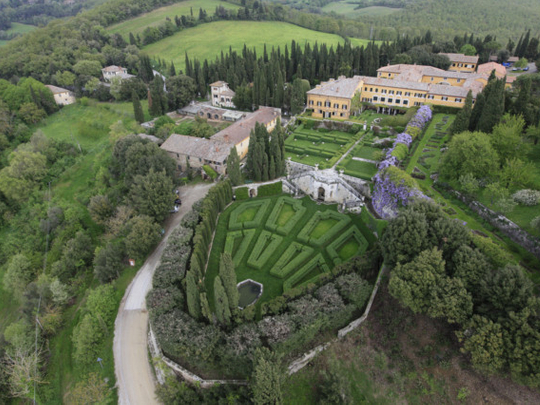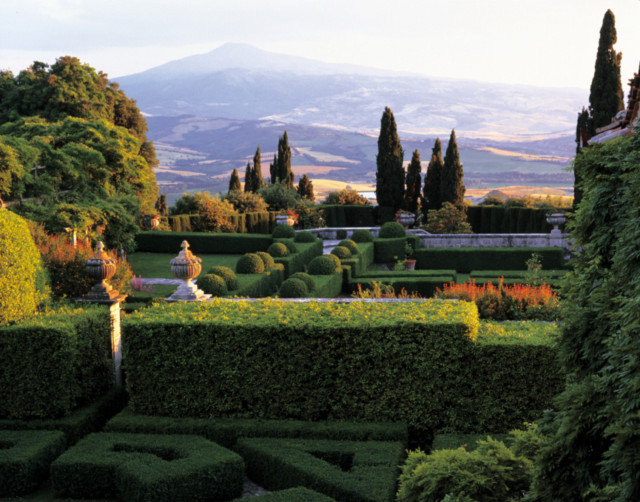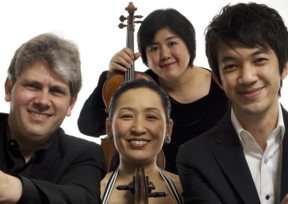
The sound of a cello being tuned reaches the broad terrace of La Foce, an elegant mansion that stands on a Tuscan hillside. A perfect accompaniment to the view that stretches above squares of box hedges, pruned to parade ground precision, and across the chequered patchwork of harvested fields to Monte Amiati rising above the haze.
Flower beds full of alium and penstemon flounce their way into the wilder reaches of the gardens with their beech and chestnut trees. It could be paradise.
La Foce, 97km south of Siena, was once a 15th century hostel for pilgrims, now it is the heart of a chamber music festival, Incontri in Terra di Siena, which, every July, fills tiny churches, hill top mediaeval villages, public squares and a castle with the sound of Bach, Mozart, Dvorak and Schubert.
The house, typically Tuscan with its mellow sandy walls and terracotta tiled roofs, was bought in 1924 by Antonio Origo, an Italian nobleman from Florence, and Iris, his young wife, who dedicated their lives to bringing change to what was an impoverished area. They created a thriving community, producing oil, planting olive groves and fruit trees and expanding the estate to more than 2,800 hectares with 57 farms.
During the Second World War, the Origos remained at La Foce and sheltered evacuated children and British and American prisoners of war on the run from the Nazis — experiences Iris recorded in a book of those gruelling years, “War in Val d’Orcia, An Italian War Diary 1943-1944”.
With the end of the conflict all they had achieved fell into disrepair and the farmers drifted back to the cities.
Iris Origo’s grandson, the cellist Antonio Lysy, who is artistic director of the festival, says: “The land started to look ugly, decayed and neglected, so we decided to start the festival the year before grandmother died in 1988. In a way it is a similar idea to hers — trying to revitalise the area using culture to bring people back here.”
Mr Lysy, who is Professor of Cello at the University of California in Los Angeles, says: “I have amazing memories of the place when I was growing up and when I used to come here in the summers from Menuhin Music Academy in Gstaad where I was studying. One day I took my cello to the Casteluccio, an abandoned castle on the hill above the house, and I played some Bach. The acoustics were perfect. Wow. I thought maybe we could have a festival to help bring people back here because it was important to share this place and not abandon it.”
This summer there will be ten different concerts in ten separate venues around La Foce. In what is quite a coup, they include a performance by Russian violinist and conductor Maxim Vengerov who will play with young students from the International Menuhin Music Academy, a group of 16 young string players from the UCLA Herb Alpert School of Music in Los Angeles where Lysy teaches. The Polyphony Youth Ensemble, young Arab and Jewish musicians from Nazareth and Jaffa Conservatoires will be joined by pianist Saleem Aboud Ashkar.
Boston-based Borromeo String Quartet will perform a complete cycle of string quartets by Béla Bartok while the ensemble Soqquadro Italiano will open the festival with a programme that traces the history of Italian song from the 16th century to the 1960s.
In confirmation of the event’s growing prestige, the conductor and composer Sir John Eliot Gardiner is to give a talk based on a book he has written on Bach.
What makes the week so splendidly sybaritic is not just the music but the venues for the concerts themselves. In the courtyard of the La Foce itself there will be a concert of Italian song from the 16th century to the 1960s.
It will be possible to listen to Antonio Lysy playing the cello in the unadorned church of Saint Andrea in Castiglioncello del Trinoro, high above the Tuscan countryside. Much of the entire hamlet has been taken over by the Monterverdi Hotel and so far three houses have been converted into the seven luxurious suites. There’s a bar for a pre-concert glass of refreshment and bruschetta and a restaurant where local treats such as the meat sauce pasta, black and white truffles are served.
The small town of Pienza, with the Church of Piave de Corisignano which is so lopsided it looks as if it is going to topple into the valley, is another concert venue which, happily, boasts a hotel in what was a 15th century nunnery. Called La Bandita, it is run by an American expat and has a Scottish chef whose speciality is bangers and truffles mash.
Places to stay include some of the 15 outlying farms belonging to La Foce, which had fallen into neglect after the war, and now have been converted into nine sophisticated villas and 10 apartments. Accommodation ranges from B&B at the Palazzolo (From €120 (Dh599) to €140 per night) to the Villa-Sassaia with its seven bedrooms above an old barn which has been converted into a summer room and a spiral Renaissance-style travertine staircase which leads to a light filled living area.
Antonio Lysy says: “We want to bring people together here. It is about the music but it’s also about the people and it’s about the place.”
www.itslafoce.org Saturday 19 – Sunday 27 July 2014
Three of the rest.
The Puccini Festival of Torre del Lago, Tuscany.
Dedicated to Giacomo Puccini, who settled in Torre del Lago, near Viareggio on the Tuscany coast in 1891. Modern amphitheatre to stage programme including “Madame Butterfly”, “La Boheme”, “Turandot”.
July 25–August 9. www.puccinifestival.it
Umbria Jazz Festival, Perugia, Umbria.
Dr John plays Louis Armstrong, plus Herbie Hancock, the Wayne Shorter Duo and the standard bearers of today’s soul music, The Daptone Super Soul Revue from New York.
July 11-20. www.umbriajazz.com
Sferisterio Opera Festival, Macerata, Marche.
One of Italy’s top opera venues — the striking arena with its colonnades built between 1820 and 1829. First class acoustics. Performing “Aida”, “Tosca” and “La Traviata”.
July 18-August 9. www.sferisterio.it
sidebar:
The visionary performances of the Borromeo String Quartet have established it as one of the most important string quartets of our time. The Chicago Tribune calls the Borromeo “a remarkably accomplished string quartet, not simply for its high technical polish and refined tone, but more importantly for the searching musical insights it brings.”
Formed in 1989, the Borromeo Quartet performs worldwide and has collaborated with many of the great composers and performers of our time. Audiences and critics alike champion the Borromeo’s ability to bring back the contemporary fire to often-heard repertoire, while making even the most challenging new music approachable. “To hear and see them perform has always felt to me like taking a private tour through a composer’s mind,” says Cathy Fuller, Classical New England host on WGBH, Boston’s famed NPR station. “They probe and analyse from every angle until they discover how to best unveil the psychological, physical, and spiritual states that a great piece of music evokes. They’re champions of new music … but they also thrive on making the old classics sound vital and fresh.”
The Borromeo is redefining the classical music landscape through the pioneering the use of computers that enable each musician to perform entirely from full four-part scores instead of individual parts, a revealing and transformative experience which has never before been possible. The group often features onstage projections of handwritten manuscripts by composers such as Beethoven, Schubert, and Bartok to vividly illustrate the creative process hard at work, a practice that has excited audiences of all ages.
“The digital tide washing over society is lapping at the shores of classical music. The Borromeo players have embraced it in their daily musical lives like no other major chamber music group,” says New York Times writer Dan Wakin in his Arts & Leisure story on the quartet, “Bytes and Beethoven”.
The ensemble makes its own concert recordings and videos while on tour, and in 2003 started The Living Archive, an on-demand recording project that made it possible for listeners to experience many of the quartet’s concerts around the world.
–Richard Holledge is a writer based in London














